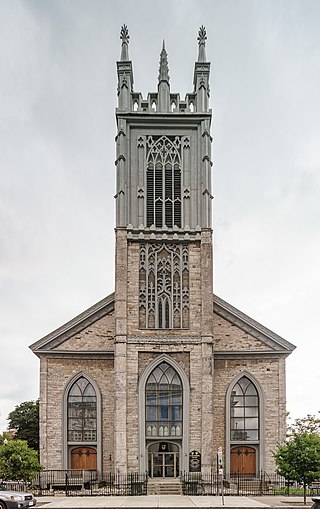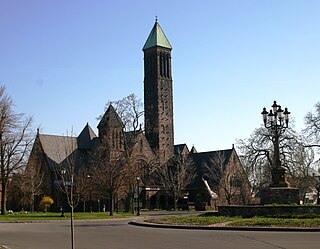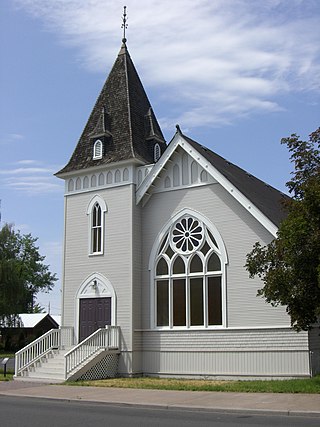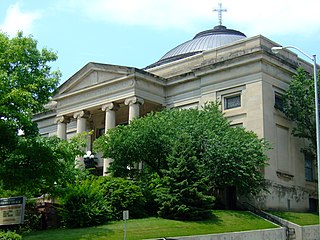
The Cathedral Basilica of Our Lady of Peace is the mother church and cathedral of the Diocese of Honolulu.

St. Wenceslaus is a church of the Roman Catholic Archdiocese of Chicago located at 3400 North Monticello Avenue in the Avondale neighborhood of Chicago, Illinois, USA.

The Cathedral of Saint Joseph of Wheeling or Saint Joseph's Cathedral is the seat of the bishop of the Catholic Diocese of Wheeling–Charleston. In addition to being the seat of the bishop, the cathedral is home to the oldest congregation in the city of Wheeling, West Virginia. The cathedral is a contributing property to the East Wheeling Historic District on the National Register of Historic Places.

St Mary's Ecumenical Church is a Church of England / Methodist Local Ecumenical Project in the village of Weaverham, Cheshire, England. The church is the parish church of Weaverham and Acton Bridge and part of the Methodist Northwich and Winsford Circuit. The vision of the church is to share the light and hope of Jesus with the local community. The church building is recorded in the National Heritage List for England as a designated Grade I listed building. It is an active Anglican parish church in the Diocese of Chester, the archdeaconry of Chester and the deanery of Middlewich.

St. Paul's Episcopal Church in Troy, New York, United States, is located at Third and State streets. It is home to one of the oldest congregations in the city. In 1979, the church and two outbuildings were added to the National Register of Historic Places. Seven years later, when the Central Troy Historic District was created and added to the Register, it was listed as a contributing property.

Government Street Presbyterian Church in Mobile, Alabama is one of the oldest and least-altered Greek Revival church buildings in the United States. The architectural design is by James Gallier Sr., James H. Dakin, and Charles Dakin. The trio also designed Barton Academy, four blocks down Government Street to the west. Government Street Presbyterian reflects the influences of Ithiel Town, Minard Lafever, and Andrew Jackson Downing. It was declared a National Historic Landmark in 1992.

Salem First United Methodist Church is a Methodist congregation and historic church in Salem, Oregon, United States. The church was listed on the National Register of Historic Places under its original name, First Methodist Episcopal Church of Salem, in 1983. First United is the oldest Methodist church west of the Rocky Mountains, and is a designated United Methodist Heritage Landmark. It is one of Oregon's few high-style Gothic Revival churches outside of Portland, and has one of the rare tall spires left standing in the state.

Bethel Methodist Church is a congregation and the building located at 57 Pitt St. The congregation organized in the late eighteenth century and originally built a smaller wooden church on the site. It served both white and black Methodists.

St. John the Evangelist is a historic Roman Catholic Church at 2270 Massachusetts Avenue in Cambridge, Massachusetts.

The First Presbyterian Church in Buffalo, New York was the first organized religious body formed in what was then the western frontier of New York State. The town of Buffalo was sparsely populated when the church was organized on February 2, 1812. However, having survived the War of 1812, the town of Buffalo was rebuilt and rapidly grew with the completion of the Erie Canal in 1825. The first two buildings were located on the same downtown lot. However, the congregation relocated between 1889 and 1891 to its present location approximately one and-a-half miles to the north in a more residential area.

Built in 1912, the First Presbyterian Church of Redmond is the oldest standing church structure in the city of Redmond, Oregon, United States. It is also the second-oldest religious building in Deschutes County. The church was built in the Gothic Revival style with Queen Anne architectural detailing. It was the home of Protestant congregations from 1912 until 1979. Today, the building is privately owned and used as a special events venue. The First Presbyterian Church of Redmond was listed on the National Register of Historic Places in 2001.

The Cotton Mountain Community Church, also known as the Wolfeborough, Brookfield and Wakefield Meetinghouse, is a historic church on Stoneham Road in Wolfeboro, New Hampshire, near the town line with Brookfield. Built about 1852, it is a well-preserved example of a rural New England meeting house with vernacular Greek Revival style. The building was listed on the National Register of Historic Places in 1985. Since 1957, when it stopped being used for services, it has been cared for by a local nonprofit group.

The Old Brick Church is a historic church building off Vermont Route 35 in Athens, Vermont. Built in 1817, it is a modest Federal style brick structure that served as a church and civic center into the 20th century. Architecturally it represents a transitional period, built with the furnishings of a typical 18th-century New England colonial meeting house, arranged on the long axis as was typical of 19th-century churches. It is now owned by the town, and was listed on the National Register of Historic Places in 1979.

Tompkins Corners United Methodist Church - now known as the Tompkins Corners Cultural Center - is located along Peekskill Hollow Road in Putnam Valley, New York, United States. It is a wooden frame structure built in the 1890s. In 1983 it was listed on the National Register of Historic Places, the only property exclusively in Putnam Valley to so far receive that distinction.

First United Methodist Church is located in downtown Des Moines, Iowa, United States. It has been listed on the National Register of Historic Places since 1984 as First Methodist Episcopal Church, which is its original name.

Old East Paint Creek Lutheran Church is located north of Waterville, Iowa, United States. The church building was listed on the National Register of Historic Places in 1983.

St Nicholas' Church, Sturry, is a joint Anglican and Methodist church standing on a bank beside the River Stour, in the village of Sturry, near Canterbury, in East Kent. The Local Ecumenical Partnership enables the congregation to be of mixed denomination - either Methodist or Anglican.

The Clinton African Methodist Episcopal Zion Church is a historic church at 9 Elm Court in Great Barrington, Massachusetts. It was the first African American church in Berkshire County, and it was a place where noted Great Barrington native W.E.B. Du Bois is known to have attended services. The Shingle style church was completed in 1887, and continues to serve as a center of African American worship in southern Berkshire County.

Roberts Park Methodist Episcopal Church, whose present-day name is Roberts Park United Methodist Church, was dedicated on August 27, 1876, making it one of the oldest church remaining in downtown Indianapolis. Diedrich A. Bohlen, a German-born architect who immigrated to Indianapolis in the 1850s, designed this early example of Romanesque Revival architecture. The church is considered one of Bohlen's major works. Constructed of Indiana limestone at Delaware and Vermont Streets, it has a rectangular plan and includes a bell tower on the southwest corner. The church is known for its interior woodwork, especially a pair of black-walnut staircases leading to galleries (balconies) surrounding the interior of three sides of its large sanctuary. The church was added to the National Register of Historic Places on August 19, 1982. It is home to one of several Homeless Jesus statues around the world, this one located behind the church on Alabama Street.

The Elk Rapids First Methodist Episcopal Church is a former church located at 301 Traverse Street in Elk Rapids, Michigan. The building now houses Elk Rapids Area Historical Museum. It was listed on the National Register of Historic Places in 2015.

























